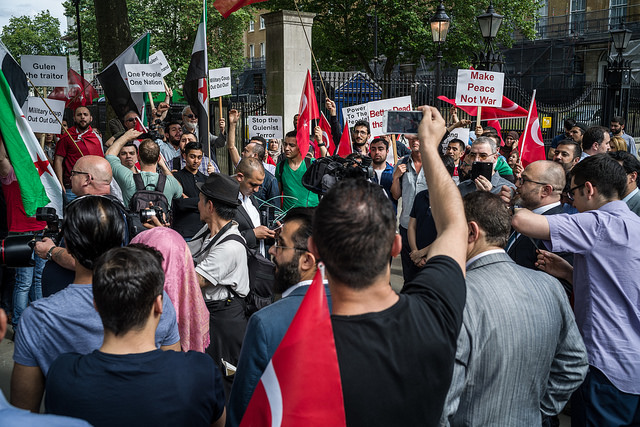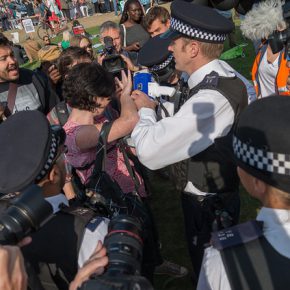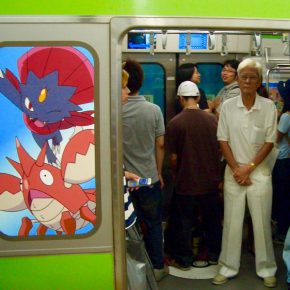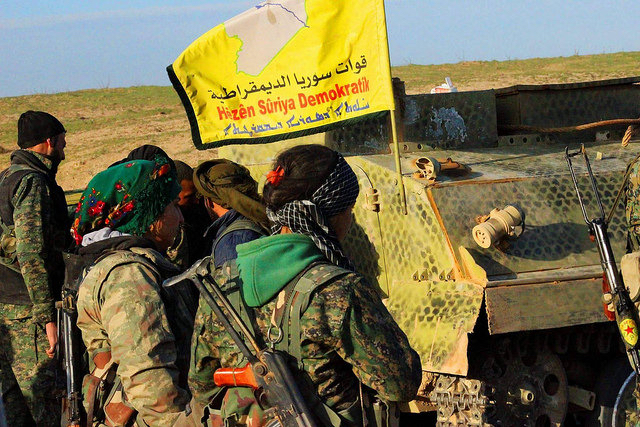The long-expected military move against the AKP had finally arrived this past weekend, but unlike previous Turkish coups, events turned against the putschists rapidly. The counter-coup marked an unprecedented national defense of Turkey’s electoral process. And yes, the AKP’s actions have repeatedly harmed this process over the past few years – so too, are its mass firings of thousands of civil servants on “enemies lists” prepared well before the coup.
But it is a process that represents a major improvement over the past constitutional disorder, of the years of the “dirty war” where the state turned its machinery on dissidents to make them disappear en masse. People came out this past weekend against that kind of Bonapartism, even if the leader they saved is acting like a Little Napoleon himself.
The government had some forewarning of a plot, which appears to have prompted the plotters to act before they could bring more soldiers into their confidence. So, on the night of July 15-16 ahead of a major strategy conference that would have dealt with these allegations, elements of the Turkish armed forces sealed off and occupied the two main bridge spans connecting Istanbul with mainland Turkey.
Within an hour of this action, initially portrayed as a counterterrorism move, reports surfaced of the Turkish Gendarmerie disarming police officers and of armored units moving to secure key buildings in both Ankara and Istanbul. Multiple aircraft takeoffs from Turkish military airports were also soon reported – apparently in support of the coup. At this time, Prime Minister Binali Yidirim announced a coup had been launched against the government. President Erdogan was holidaying at a resort in Marmaris on the Mediterranean and the chief of the general staff was taken hostage in Ankara.
At first, the situation seemed to be going poorly for the government. Erdogan was nowhere to be found, the intelligence agencies seem to have totally dropped the ball and come under fire (literally) from the putschists. UN agencies and foreign embassies notified staff and nationals to shelter in place, and EU diplomats told Reuters the plot looked “well orchestrated”.
As more soldiers were deployed in Ankara and Istanbul, anti-government elements of the air force and the army began firing upon government buildings in Ankara. The military either attacked or occupied the national police training center, the general staff HQ, Taksim Square in Istanbul, the houses of parliament, Ataturk International Airport, Sabiha Gökçen International Airport, state TV buildings in Ankara, the country’s primary satellite TV provider, Turkish Intelligence commands in Ankara, government palaces, and the AKP’s main office in Istanbul.
State-owned media were forced to suspend broadcasting, though not before their employees were held at gunpoint and made to air a statement from the “Peace Council” – the name the putschists gave themselves – proclaiming that a curfew and martial law were in effect nationwide. Initially, few people came out in violation of the curfew, but as the armed forces failed to enforce the curfew, more emerged.
Social media access was interrupted, but did not go entirely offline at any point. Though the putschists attempted to seize telecommunications hubs, by and large they acted as though it was the 1980s again, when the Internet did not exist. Already, their efforts at information control were failing as Turks turned to live streaming apps, VPNs, and mobile devices for news. The private broadcaster CNN Turk, for example, enacted a contingency plan that would prevent the military from disabling their broadcasting feeds even if they occupied the station.
Then, the putschists failed in the single most important step of their coup: eliminating the head of state. Erdogan not only escaped the resort on the Turkish Riviera he was staying at ahead of an airborne assault, but also got up in the air in his private jet. It appears no shoot-down order was given to the putschist planes trailing the plane, though why this was the case in unclear. Perhaps it is because no one wanted to make that call, or the pilots did not think they would survive the loyalist retaliation, or the plan was in fact (as suggested by the raid on the resort) always to capture Erdogan alive and force him to tell his supporters to stand down.
Whatever the reasoning, it marked the beginning of the end for the putschists that night. They now had a much harder time putting out their version of events to sway others to their cause. Erdogan broadcast a call to arms for AKP supporters using FaceTime, a platform favored by Turkish netizens alongside Facebook Live and Periscope as alternatives to traditional media the AKP has increasingly taken to censoring and micromanaging.
Erdogan’s use of these tools, alongside the Twitter platform he has much maligned over the years, was an implicit recognition of how popular they have become. Apparently totally lost on him, though, is why his government’s censorious, anti-journalistic policies have made these services necessary.
While Erdogan was delivering this address, now three hours into the coup, much of the country’s religious establishment took to the mosques to call for protests in his support – mobilizing those who weren’t glued to their phones and convincing many it was their pious duty to go out and protest. The putschists also failed to take measures against this, as it was noted that no one stopped people from going to their mosques or cut the power to the loudspeakers that, instead of broadcasting the call to prayer, broadcasted pro-AKP slogans.
The mosques, alongside ruling party functionaries, amplified the message for people to come out into the street to defy the putschists. Outside of Ankara and Istanbul, the security forces appeared unsure of what to do without clear instructions or an alternative chain of command. Soldiers by and large stayed in their barracks – those who had come out were lied to about why they’d been deployed – and police remained on patrol.
In several cities, the putschists also failed to seal off the local AKP offices. Even in Diyarbakir, a mostly Kurdish town where Erdogan is not especially popular and whose air force units apparently joined in the putsch, curfews went unenforced and protestors, ranging from the Islamist far-right to Kurdish autonomists, gathered in front of the local AKP building.
As the night wore on, all of the country’s opposition parties came out against the coup: if any had been consulted by the plotters in advance, they did not show their hand. There is, in fact, no evidence such treasonous discussions even took place or would have gone very far (the AKP, though, suspects collusion within its own ranks). The police even called for demonstrations, too – ironic for a force that has been out in force since 2013 against non-violent, anti-AKP protestors. Much of the army joined the police in rejecting the putsch as did the navy, the special operations forces, and the intelligence community.
Demonstrators in Istanbul were emboldened by the putschists’ indecision and occupied Taksim Square and Ataturk International Airport early in the morning. They clashed with the troops sent then by the putschists, but many soldiers also refused to fire on the civilians (notable exceptions being at the Bosporous crossings, where one of Erdogan’s top aides was among the civilians killed, and in Ankara). Soldiers surrendered and were disarmed and arrested by police or civilians. The conscript army was by and large unaware of what was going on, betrayed by their commanding officers and left to either fight on and die, hope to safely surrender, or be taken down by loyalists.
Reports them began circulating that several of the putschists’ warplanes had been shot down and Erdogan was arriving at Ataturk International Airport. By this time, demonstrations had gone on in the provinces for hours without serious resistance, outside of the country’s two main cities. Erdogan gave a speech at Ataturk after landing, calling the coup a putsch by Gulenists, former allies of the AKP, now turned bitter foes. (The founder of the movement, Fethullah Gülen, claims to have no involvement and suggested it was a “self-coup” by Erdogan.)
During the early morning hours, the government finally gained the upper hand, but the putschists now moved to attack or occupied number of privately owned Turkish media outlets, which they had failed to deal with beforehand. At least 3 media workers were killed in total, from Turksat TV in Ankara and the Yeni Safak newspaper in Istanbul. The newspaper Hurriyet’s staff faced a hostage situation that was fortunately resolved without loss of life, and reporters were also held gunpoint in the CNN Turk, Digiturk, and TRT newsrooms. Though all of these outlets were allowed back on the air eventually, several other news organizations have since been banned by the government.
https://www.youtube.com/watch?v=yzb8k2Cdt4g
While Istanbul seemed to be returning to government control at 05:00 local time, Ankara remained a war zone and loyalist planes were deployed against the putschists. In Ankara, the houses of parliament were hit hardest, forcing MPs from all of the country’s political parties into bunkers below the building. Anti-government forces continued to resist in Istanbul and Ankara when dawn broke, but the AKP government is now back in control. Holdouts in Istanbul surrendered by 07:00 local time on the Bosporous bridges. Fighting continued in Ankara for some time still, both on the ground and in the air, before finally petering out late on Saturday.
What this all means for the region is even less clear: only the Government of Qatar and Hamas can be said to sincerely welcome Erdogan’s survival. (Egypt and Syria, for instance, were cheering loudly for the “Peace Council” to win.) The bigger “optics” problem right now though is for the United States. Turkish airspace was declared closed to all traffic, including USAF flights out of the joint Incirlik Air Base. The facility was locked down and had to go to emergency power due to the Turks cutting off its electricity. Incirlik may host the USAF but it is a Turkish airbase and was in fact key to the coup’s logistics.
This is cause enough for AKP leaders to insist the US knew exactly what was happening and either did nothing or enabled it. The White House has professed it was taken by surprise, but is now in the awkward position of balancing its regional anti-ISIS strategy against Erdogan’s anger and insistence that Fethullah Gulen, living in exile in the US, be extradited home, where he and his supporters are almost sure to not be guaranteed a fair trial based on past precedent and the current overcharged political atmosphere.
Over 15,000 soldiers and police have been removed from their posts, alongside 3,000 judicials, including high-ranking commanders from all service branches and top judges. Ten of thousands of civil servants and teachers have also been fired. And now, hundreds of journalists are being investigated, including state TV employees who were acting under duress. Presumably, these individuals were already on internal security lists and marked for “questionable” loyalty ahead of the putsch.
It remains to be seen how many of those now being held are actually guilty of treason, or just being removed for their dissenting views at an opportune moment. Given the failure of the plot, it is hard to imagine even most of these individuals, numbering in the tens of thousands, could have been “in” on such an unpopular, poorly planned plot. Nonetheless, Erdogan has taken the events as a mandate to clean house – one must ask, who will replace all of these people?
This is the tragedy of the coup: the putschists wanted to institute a dictatorship and, while failing, have boosted dictatorial impulses within the ruling party. Turkish republicans have fought long and hard against those impulses in the country’s political life. From 1960 on, the military has time and again exercised its self-appointed “right” to decide the fate of the country by secret committee and “a whiff of grapeshot.” Under the AKP’s terms in office, Turkey has made real progress against that kind of domestic intervention.
https://www.youtube.com/watch?v=k67nQB60q1s
But after twelve years of progress in that area, the ruling party has grown fat and content, and especially arrogant: dismissing the opposition parties as foreign agents, threatening human rights activists, and harassing reporters for daring to ask where lucrative government contracts are going or reporting on arms smuggling into Syria. Erdogan’s rhetoric and actions increasingly show that he feels his coup-proofing of the country’s institutions and large re-election margins justifies self-enrichment, cronyism, and smear campaigns.
The AKP is, in the wake of the coup, talking of revising the constitution and increasing the powers of the presidency to combat terrorism. It is a not-unreasonable plan of action, but how it is done will matter as much as the terms proposed, especially if a snap referendum or parliamentary elections are called. The AKP must move carefully, because even after the country came together to stop the coup, opposition party offices, ethnic and religious minorities, and refugees are coming under assault by those claiming to be acting in Erdogan’s name.
The unity attained by opposition to the putsch would be a terrible thing to squander. Yet in the end, for all Erdogan’s many faults and abuses, it was the armed forces, the supposed guarantors of the republican state for decades, who have done the most to strengthen Turkey’s illiberal democrats now, and set back civil-military relations for years to come. In trying to set up an illiberal, dictatorial order to safeguard “the state” they have ensured the consolidation of illiberal democracy.
Photograph courtesy of Gordon. Published under a Creative Commons license.





